Berg J.M., Tymoczko J.L., Stryer L. Biochemistry
Подождите немного. Документ загружается.

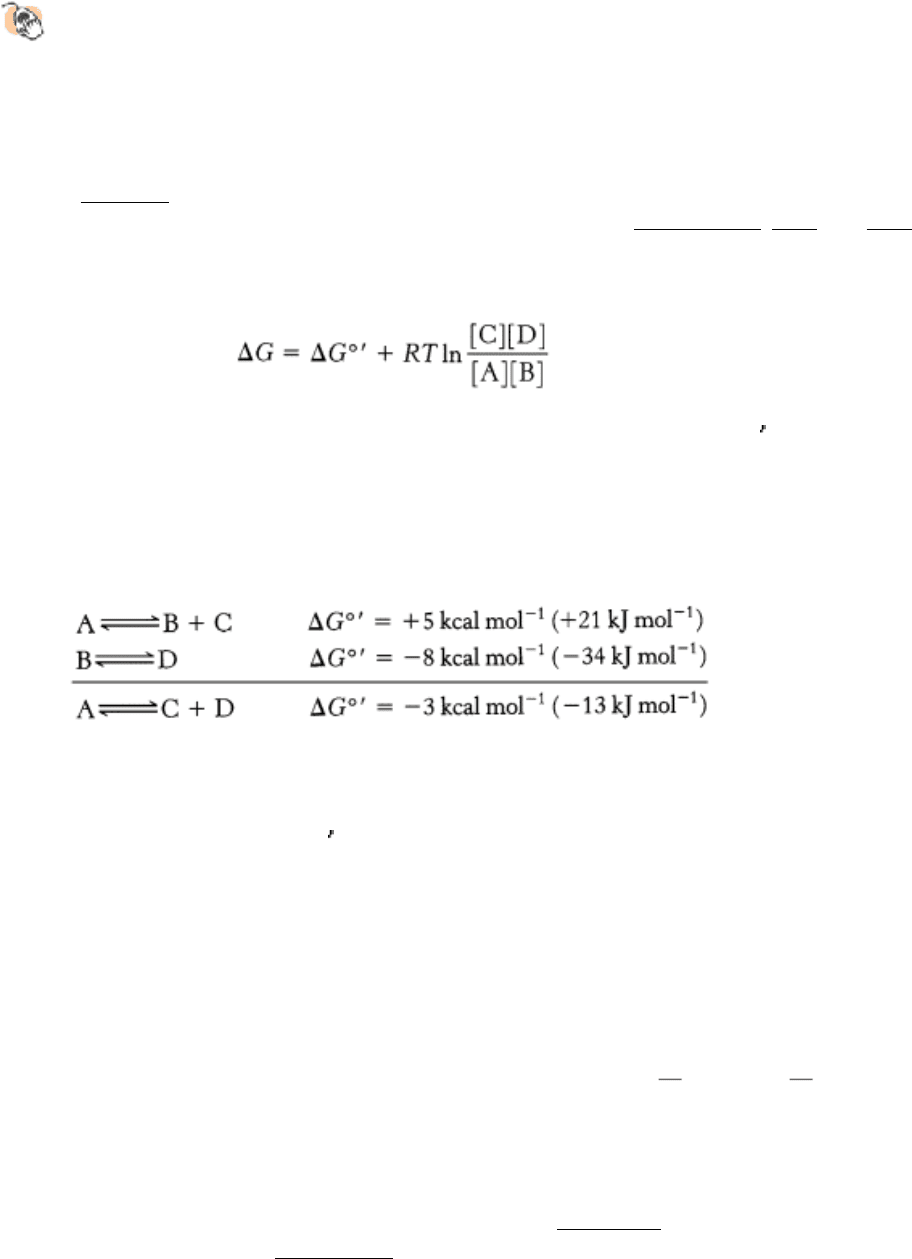
Conceptual Insights, Energetic Coupling, offers a graphical presentation of
how enzymatic coupling enables a favorable reaction to drive an unfavorable
reaction.
How are specific pathways constructed from individual reactions? A pathway must satisfy minimally two criteria: (1) the
individual reactions must be specific and (2) the entire set of reactions that constitute the pathway must be
thermodynamically favored. A reaction that is specific will yield only one particular product or set of products from its
reactants. As discussed in Chapter 8, a function of enzymes is to provide this specificity. The thermodynamics of
metabolism is most readily approached in terms of free energy, which was discussed in Sections 1.3.3, 8.2.1, and 8.2.2.
A reaction can occur spontaneously only if ∆ G, the change in free energy, is negative. Recall that ∆ G for the formation
of products C and D from substrates A and B is given by
Thus, the ∆ G of a reaction depends on the nature of the reactant and products (expressed by the ∆ G°
term, the standard
free-energy change) and on their concentrations (expressed by the second term).
An important thermodynamic fact is that the overall free-energy change for a chemically coupled series of reactions is
equal to the sum of the freeenergy changes of the individual steps. Consider the following reactions:
Under standard conditions, A cannot be spontaneously converted into B and C, because ∆ G is positive. However, the
conversion of B into D under standard conditions is thermodynamically feasible. Because free- energy changes are
additive, the conversion of A into C and D has a ∆ G°
of -3 kcal mol
-1
(-13 kJ mol
-1
), which means that it can occur
spontaneously under standard conditions. Thus, a thermodynamically unfavorable reaction can be driven by a
thermodynamically favorable reaction to which it is coupled. In this example, the chemical intermediate B, common to
both reactions, couples the reactions. Thus, metabolic pathways are formed by the coupling of enzyme-catalyzed
reactions such that the overall free energy of the pathway is negative.
14.1.2. ATP Is the Universal Currency of Free Energy in Biological Systems
Just as commerce is facilitated by the use of a common currency, the commerce of the cell
metabolism is facilitated
by the use of a common energy currency, adenosine triphosphate (ATP). Part of the free energy derived from the
oxidation of foodstuffs and from light is transformed into this highly accessible molecule, which acts as the free-energy
donor in most energy-requiring processes such as motion, active transport, or biosynthesis.
ATP is a nucleotide consisting of an adenine, a ribose, and a triphosphate unit (Figure 14.3). The active form of ATP is
usually a complex of ATP with Mg
2+
or Mn
2+
(Section 9.4.2). In considering the role of ATP as an energy carrier, we
can focus on its triphosphate moiety. ATP is an energy-rich molecule because its triphosphate unit contains two
phosphoanhydride bonds. A large amount of free energy is liberated when ATP is hydrolyzed to adenosine diphosphate
(ADP) and orthophosphate (P
i
) or when ATP is hydrolyzed to adenosine monophosphate (AMP) and pyrophosphate
(PP
i
).
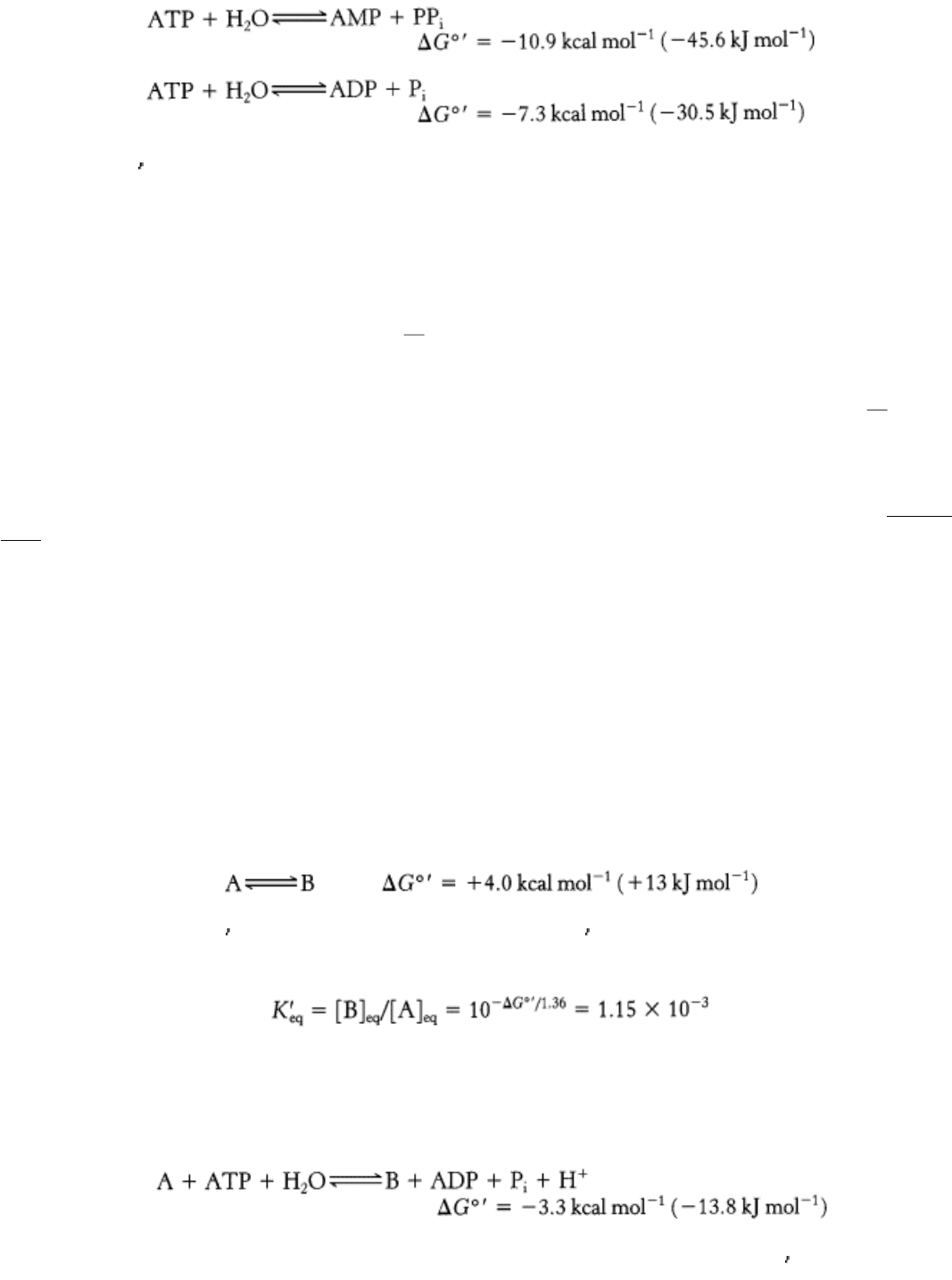
The precise ∆ G°
for these reactions depends on the ionic strength of the medium and on the concentrations of Mg
2+
and
other metal ions. Under typical cellular concentrations, the actual ∆ G for these hydrolyses is approximately -12 kcal mol
-
1
(-50 kJ mol
-1
).
The free energy liberated in the hydrolysis of ATP is harnessed to drive reactions that require an input of free energy,
such as muscle contraction. In turn, ATP is formed from ADP and P
i
when fuel molecules are oxidized in chemotrophs
or when light is trapped by phototrophs. This ATP
ADP cycle is the fundamental mode of energy exchange in
biological systems.
Some biosynthetic reactions are driven by hydrolysis of nucleoside triphosphates that are analogous to ATP
namely,
guanosine triphosphate (GTP), uridine triphosphate (UTP), and cytidine triphosphate (CTP). The diphosphate forms of
these nucleotides are denoted by GDP, UDP, and CDP, and the monophosphate forms by GMP, UMP, and CMP.
Enzymes can catalyze the transfer of the terminal phosphoryl group from one nucleotide to another. The phosphorylation
of nucleoside monophosphates is catalyzed by a family of nucleoside monophosphate kinases, as discussed in Section
9.4.1. The phosphorylation of nucleoside diphosphates is catalyzed by nucleoside diphosphate kinase, an enzyme with
broad specificity. It is intriguing to note that, although all of the nucleotide triphosphates are energetically equivalent,
ATP is nonetheless the primary cellular energy carrier. In addition, two important electron carriers, NAD
+
and FAD, are
derivatives of ATP. The role of ATP in energy metabolism is paramount.
14.1.3. ATP Hydrolysis Drives Metabolism by Shifting the Equilibrium of Coupled
Reactions
How does coupling to ATP hydrolysis make possible an otherwise unfavorable reaction? Consider a chemical reaction
that is thermodynamically unfavorable without an input of free energy, a situation common to many biosynthetic
reactions. Suppose that the standard free energy of the conversion of compound A into compound B is +4.0 kcal mol
-1
(+13 kJ mol
-1
):
The equilibrium constant K
eq
of this reaction at 25°C is related to ∆ G° (in units of kilocalories per mole) by
Thus, net conversion of A into B cannot occur when the molar ratio of B to A is equal to or greater than 1.15 × 10
-3
.
However, A can be converted into B under these conditions if the reaction is coupled to the hydrolysis of ATP. The new
overall reaction is
Its standard free-energy change of -3.3 kcal mol
-1
(-13.8 kJ mol
-1
) is the sum of the value of ∆ G° for the conversion of
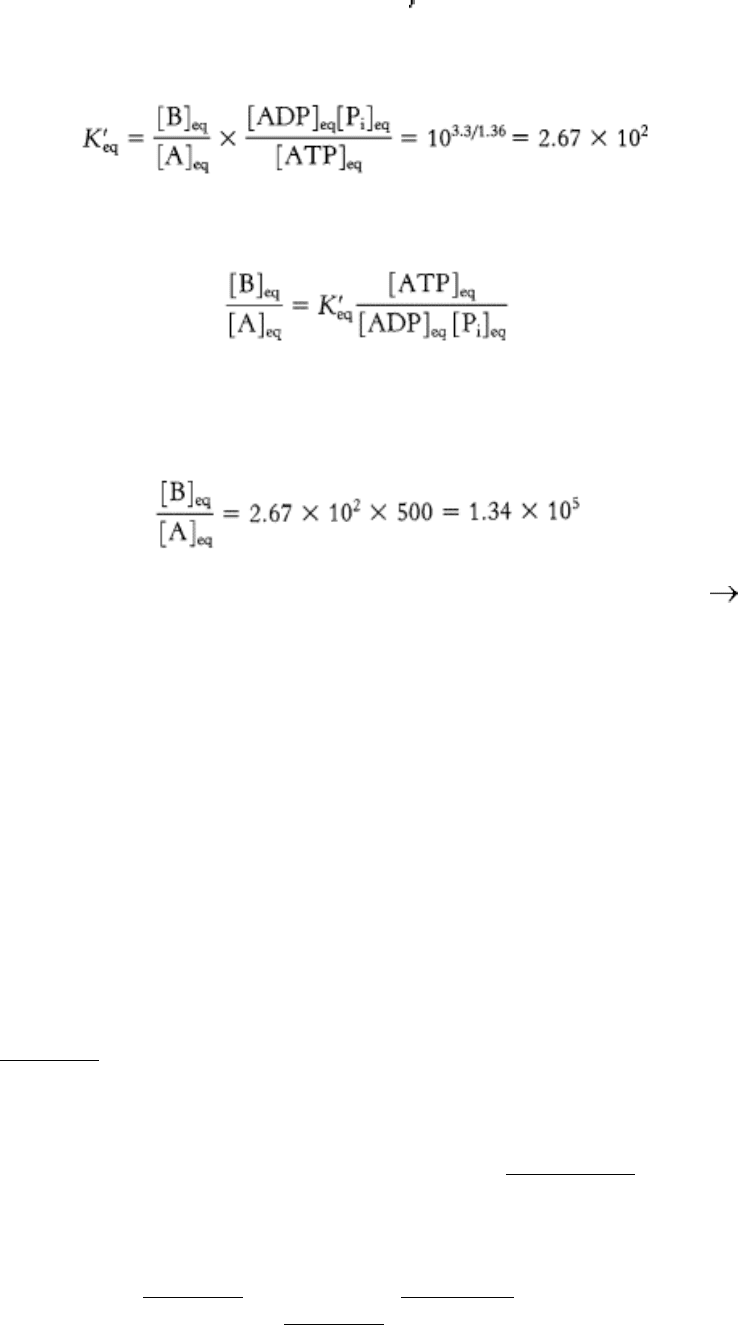
A into B [+4.0 kcal mol
-1
(+12.6 kJ mol
-1
)] and the value of ∆ G° for the hydrolysis of ATP [-7.3 kcal mol
-1
(-30.5 kJ
mol
-1
)]. At pH 7, the equilibrium constant of this coupled reaction is
At equilibrium, the ratio of [B] to [A] is given by
The ATP-generating system of cells maintains the [ATP]/[ADP][P
i
] ratio at a high level, typically of the order of 500 M
-
1
. For this ratio,
which means that the hydrolysis of ATP enables A to be converted into B until the [B]/[A] ratio reaches a value of 1.34
× 10
5
. This equilibrium ratio is strikingly different from the value of 1.15 × 10
-3
for the reaction A B in the absence
of ATP hydrolysis. In other words, coupling the hydrolysis of ATP with the conversion of A into B has changed the
equilibrium ratio of B to A by a factor of about 10
8
.
We see here the thermodynamic essence of ATP's action as an energy-coupling agent. Cells maintain a high level of
ATP by using oxidizable substrates or light as sources of free energy. The hydrolysis of an ATP molecule in a coupled
reaction then changes the equilibrium ratio of products to reactants by a very large factor, of the order of 10
8
. More
generally, the hydrolysis of n ATP molecules changes the equilibrium ratio of a coupled reaction (or sequence of
reactions) by a factor of 10
8
n
. For example, the hydrolysis of three ATP molecules in a coupled reaction changes the
equilibrium ratio by a factor of 10
24
. Thus, a thermodynamically unfavorable reaction sequence can be converted into a
favorable one by coupling it to the hydrolysis of a sufficient number of ATP molecules in a new reaction. It should also
be emphasized that A and B in the preceding coupled reaction may be interpreted very generally, not only as different
chemical species. For example, A and B may represent activated and unactivated conformations of a protein; in this case,
phosphorylation with ATP may be a means of conversion into an activated conformation. Such a conformation can store
free energy, which can then be used to drive a thermodynamically unfavorable reaction. Through such changes in
conformation, molecular motors such as myosin, kinesin, and dynein convert the chemical energy of ATP into
mechanical energy (Chapter 34). Indeed, this conversion is the basis of muscle contraction.
Alternatively, A and B may refer to the concentrations of an ion or molecule on the outside and inside of a cell, as in the
active transport of a nutrient. The active transport of Na
+
and K
+
across membranes is driven by the phosphorylation of
the sodium-potassium pump by ATP and its subsequent dephosphorylation (Section 13.2.1).
14.1.4. Structural Basis of the High Phosphoryl Transfer Potential of ATP
As illustrated by molecular motors (Chapter 34) and ion pumps (Section 13.2), phosphoryl transfer is a common means
of energy coupling. Furthermore, as we shall see in Chapter 15, phosphoryl transfer is also widely used in the
intracellular transmission of information. What makes ATP a particularly efficient phosphoryl-group donor? Let us
compare the standard free energy of hydrolysis of ATP with that of a phosphate ester, such as glycerol 3-phosphate:
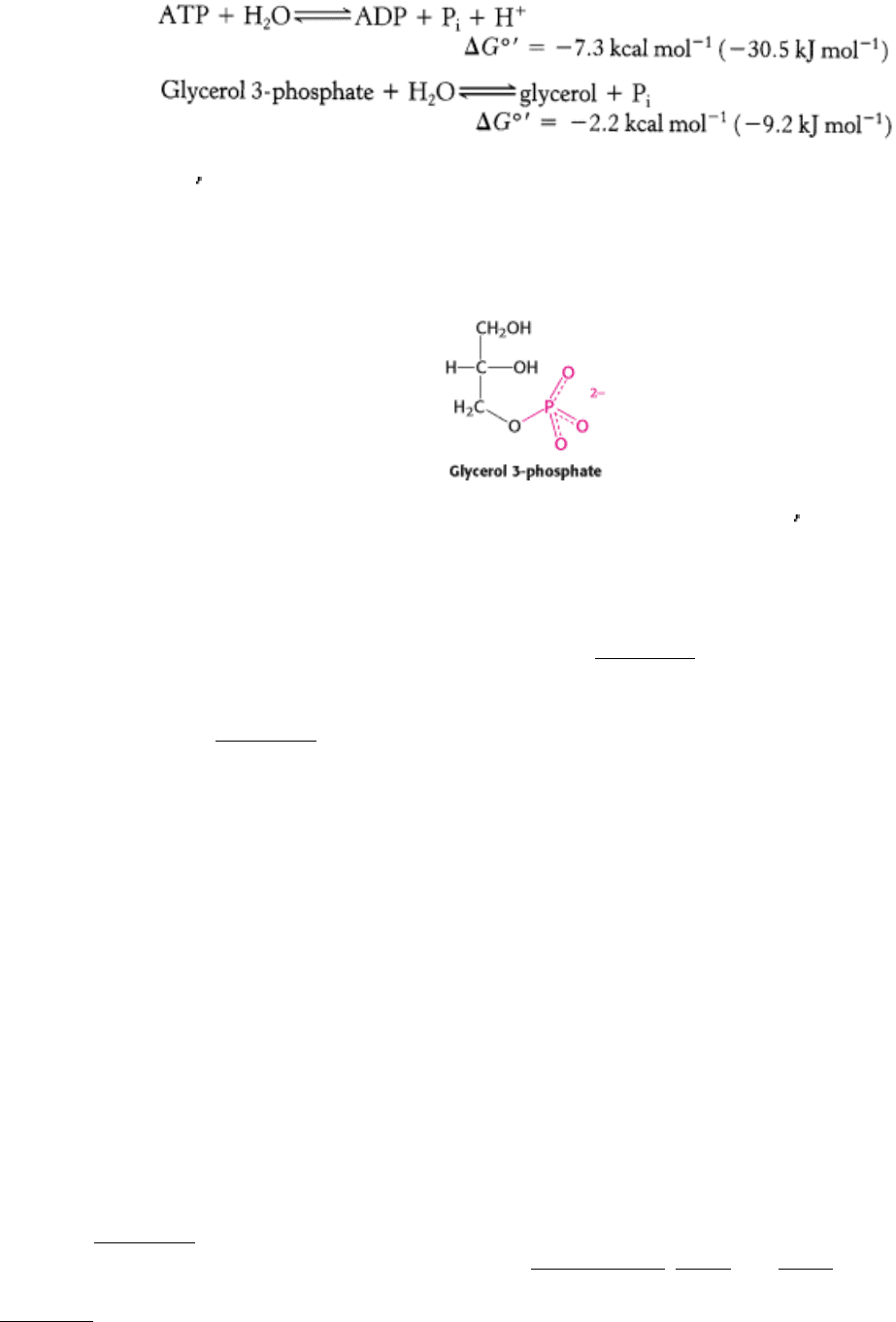
The magnitude of ∆ G°
for the hydrolysis of glycerol 3-phosphate is much smaller than that of ATP, which means that
ATP has a stronger tendency to transfer its terminal phosphoryl group to water than does glycerol 3-phosphate. In other
words, ATP has a higher phosphoryl transfer potential (phosphoryl-group transfer potential) than does glycerol 3-
phosphate.
What is the structural basis of the high phosphoryl transfer potential of ATP? Because ∆ G°
depends on the difference in
free energies of the products and reactants, the structures of both ATP and its hydrolysis products, ADP and P
i
, must be
examined to answer this question. Three factors are important: resonance stabilization, electrostatic repulsion, and
stabilization due to hydration. ADP and, particularly, P
i
, have greater resonance stabilization than does ATP.
Orthophosphate has a number of resonance forms of similar energy (Figure 14.4), whereas the γ-phosphoryl group of
ATP has a smaller number.
Forms like that shown in Figure 14.5 are unfavorable because a positively charged oxygen atom is adjacent to a
positively charged phosphorus atom, an electrostatically unfavorable juxtaposition. Furthermore, at pH 7, the
triphosphate unit of ATP carries about four negative charges. These charges repel one another because they are in close
proximity. The repulsion between them is reduced when ATP is hydrolyzed. Finally, water can bind more effectively to
ADP and P
i
than it can to the phosphoanhydride part of ATP, stabilizing the ADP and P
i
by hydration.
ATP is often called a high-energy phosphate compound, and its phosphoanhydride bonds are referred to as high-energy
bonds. Indeed, a "squiggle" (~P) is often used to indicate such a bond. Nonetheless, there is nothing special about the
bonds themselves. They are high-energy bonds in the sense that much free energy is released when they are hydrolyzed,
for the aforegiven reasons.
14.1.5. Phosphoryl Transfer Potential Is an Important Form of Cellular Energy
Transformation
The standard free energies of hydrolysis provide a convenient means of comparing the phosphoryl transfer potential of
phosphorylated compounds. Such comparisons reveal that ATP is not the only compound with a high phosphoryl
transfer potential. In fact, some compounds in biological systems have a higher phosphoryl transfer potential than that of
ATP. These compounds include phosphoenolpyruvate (PEP), 1,3-bisphosphoglycerate (1,3-BPG), and creatine
phosphate (Figure 14.6). Thus, PEP can transfer its phosphoryl group to ADP to form ATP. Indeed, this is one of the
ways in which ATP is generated in the breakdown of sugars (Sections 14.2.1, 16.1.6, and 16.1.7). It is significant that
ATP has a phosphoryl transfer potential that is intermediate among the biologically important phosphorylated molecules
(Table 14.1). This intermediate position enables ATP to function efficiently as a carrier of phosphoryl groups.
Creatine phosphate in vertebrate muscle serves as a reservoir of high-potential phosphoryl groups that can be readily
transferred to ATP. Indeed, we use creatine phosphate to regenerate ATP from ADP every time we exercise strenuously.
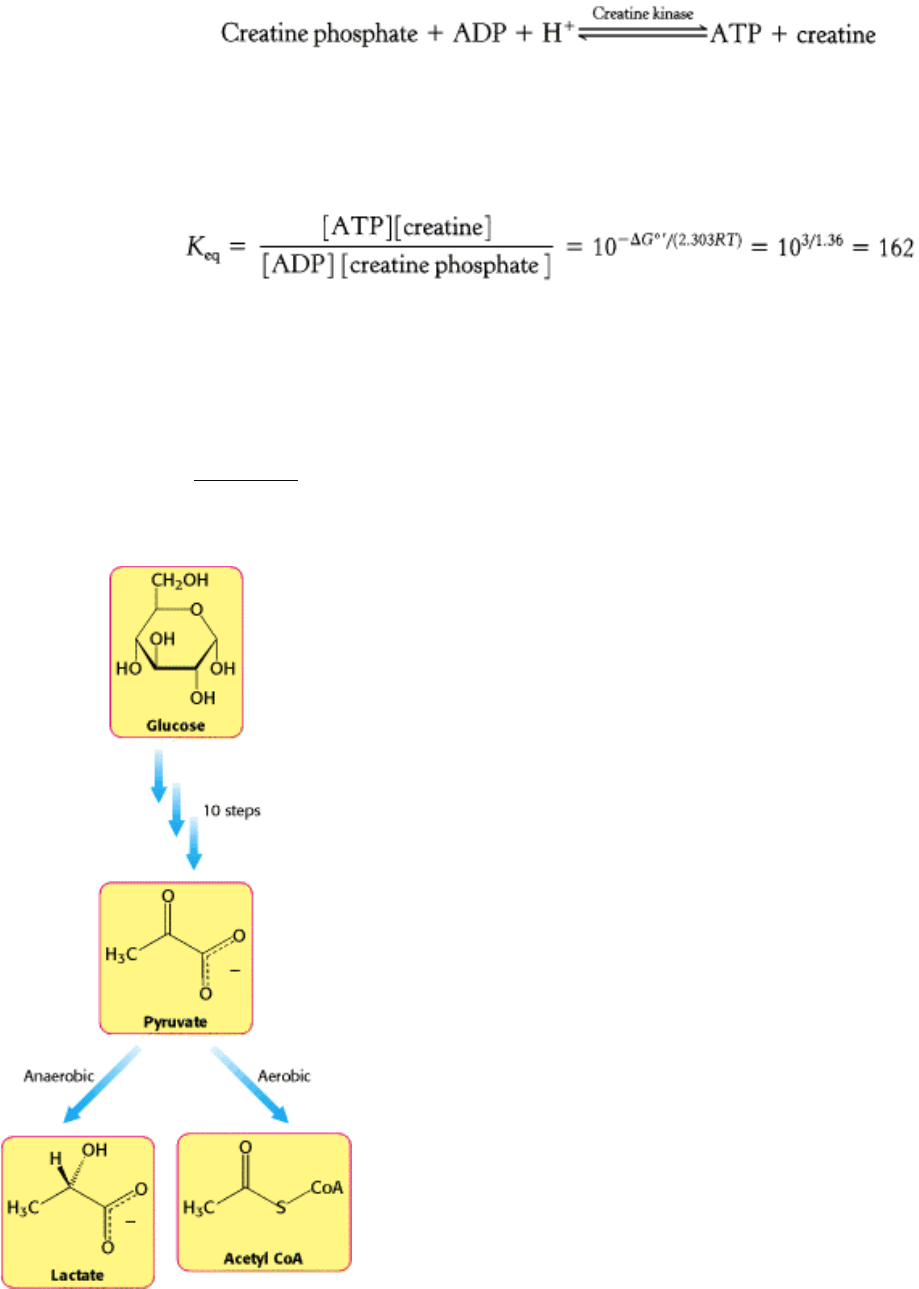
This reaction is catalyzed by creatine kinase.
At pH 7, the standard free energy of hydrolysis of creatine phosphate is -10.3 kcal mol
-1
(-43.1 kJ mol
-1
), compared with
-7.3 kcal mol
-1
(-30.5 kJ mol
-1
) for ATP. Hence, the standard free-energy change in forming ATP from creatine
phosphate is -3.0 kcal mol
-1
(-12.6 kJ mol
-1
), which corresponds to an equilibrium constant of 162.
In resting muscle, typical concentrations of these metabolites are [ATP] = 4 mM, [ADP] = 0.013 mM, [creatine
phosphate] = 25 mM, and [creatine] = 13 mM. The amount of ATP in muscle suffices to sustain contractile activity for
less than a second. The abundance of creatine phosphate and its high phosphoryl transfer potential relative to that of ATP
make it a highly effective phosphoryl buffer. Indeed, creatine phosphate is the major source of phosphoryl groups for
ATP regeneration for a runner during the first 4 seconds of a 100-meter sprint. After that, ATP must be generated
through metabolism (Figure 14.7).
II. Transducing and Storing Energy 14. Metabolism: Basic Concepts and Design 14.1. Metabolism Is Composed of Many Coupled, Interconnecting Reactions
Figure 14.1. Glucose Metabolism. Glucose is metabolized to pyruvate in 10 linked reactions. Under anaerobic
conditions, pyruvate is metabolized to lactate and, under aerobic conditions, to acetyl CoA. The glucose-derived carbons
are subsequently oxidized to CO
2
.
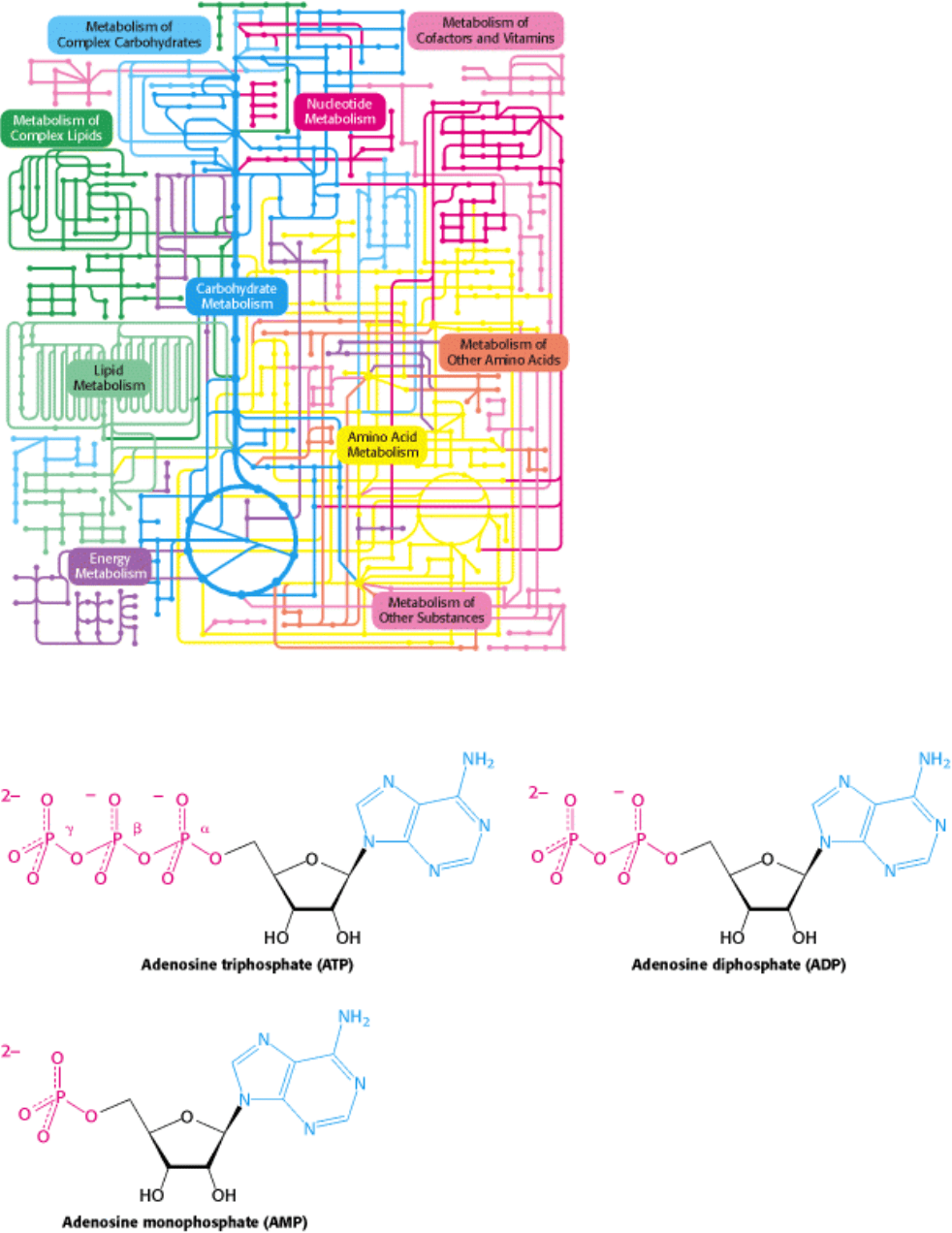
II. Transducing and Storing Energy 14. Metabolism: Basic Concepts and Design 14.1. Metabolism Is Composed of Many Coupled, Interconnecting Reactions
Figure 14.2. Metabolic Pathways. [From the Kyoto Encyclopedia of Genes and Genomes (www.genome.ad.jp/kegg).]
II. Transducing and Storing Energy 14. Metabolism: Basic Concepts and Design 14.1. Metabolism Is Composed of Many Coupled, Interconnecting Reactions
Figure 14.3. Structures of ATP, ADP, and AMP. These adenylates consist of adenine (blue), a ribose (black), and a
tri-, di-, or monophosphate unit (red). The innermost phosphorus atom of ATP is designated P
α
, the middle one P
β
, and
the outermost one P
γ
.

II. Transducing and Storing Energy 14. Metabolism: Basic Concepts and Design 14.1. Metabolism Is Composed of Many Coupled, Interconnecting Reactions
Figure 14.4. Resonance Structures of Orthophosphate.
II. Transducing and Storing Energy 14. Metabolism: Basic Concepts and Design 14.1. Metabolism Is Composed of Many Coupled, Interconnecting Reactions
Figure 14.5. Improbable Resonance Structure. The structure contributes little to the terminal part of ATP, because
two positive charges are placed adjacent to each other.
II. Transducing and Storing Energy 14. Metabolism: Basic Concepts and Design 14.1. Metabolism Is Composed of Many Coupled, Interconnecting Reactions
Figure 14.6. High Phosphoryl Transfer Potential Compounds. These compounds have a higher phosphoryl transfer
potential than that of ATP and can be used to phosphorylate ADP to form ATP.
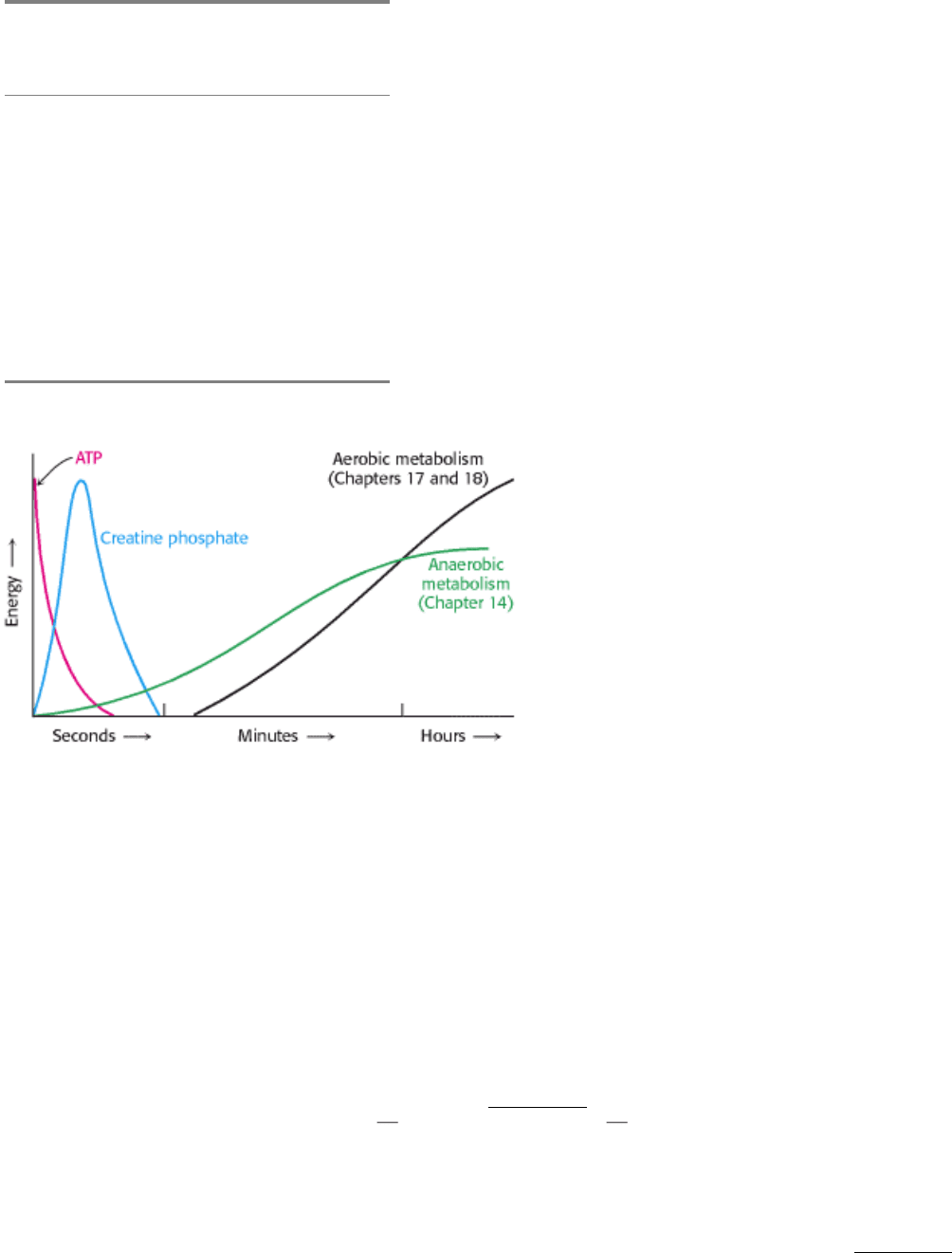
II. Transducing and Storing Energy 14. Metabolism: Basic Concepts and Design 14.1. Metabolism Is Composed of Many Coupled, Interconnecting Reactions
Table 14.1. Standard free energies of hydrolysis of some phosphorylated compounds
Compound
kcal mol
-
1
kJ mol
-
1
Phosphoenolpyruvate -14.8 -61.9
1,3-Bisphosphoglycerate -11.8 -49.4
Creatine phosphate -10.3 -43.1
ATP (to ADP) - 7.3 -30.5
Glucose 1-phosphate - 5.0 -20.9
Pyrophosphate - 4.6 -19.3
Glucose 6-phosphate - 3.3 -13.8
Glycerol 3-phosphate - 2.2 - 9.2
II. Transducing and Storing Energy 14. Metabolism: Basic Concepts and Design 14.1. Metabolism Is Composed of Many Coupled, Interconnecting Reactions
Figure 14.7. Sources of ATP During Exercise. In the initial seconds, exercise is powered by existing high phosphoryl
transfer compounds (ATP and creatine phosphate). Subsequently, the ATP must be regenerated by metabolic pathways.
II. Transducing and Storing Energy 14. Metabolism: Basic Concepts and Design
14.2. The Oxidation of Carbon Fuels Is an Important Source of Cellular Energy
ATP serves as the principal immediate donor of free energy in biological systems rather than as a long-term storage form
of free energy. In a typical cell, an ATP molecule is consumed within a minute of its formation. Although the total
quantity of ATP in the body is limited to approximately 100 g, the turnover of this small quantity of ATP is very high.
For example, a resting human being consumes about 40 kg of ATP in 24 hours. During strenuous exertion, the rate of
utilization of ATP may be as high as 0.5 kg/minute. For a 2-hour run, 60 kg (132 pounds) of ATP is utilized. Clearly, it
is vital to have mechanisms for regenerating ATP. Motion, active transport, signal amplification, and biosynthesis can
occur only if ATP is continually regenerated from ADP (Figure 14.8). The generation of ATP is one of the primary roles
of catabolism. The carbon in fuel molecules such as glucose and fats is oxidized to CO
2
, and the energy released is
used to regenerate ATP from ADP and P
i
.
In aerobic organisms, the ultimate electron acceptor in the oxidation of carbon is O
2
and the oxidation product is CO
2
.
Consequently, the more reduced a carbon is to begin with, the more exergonic its oxidation will be. Figure 14.9 shows
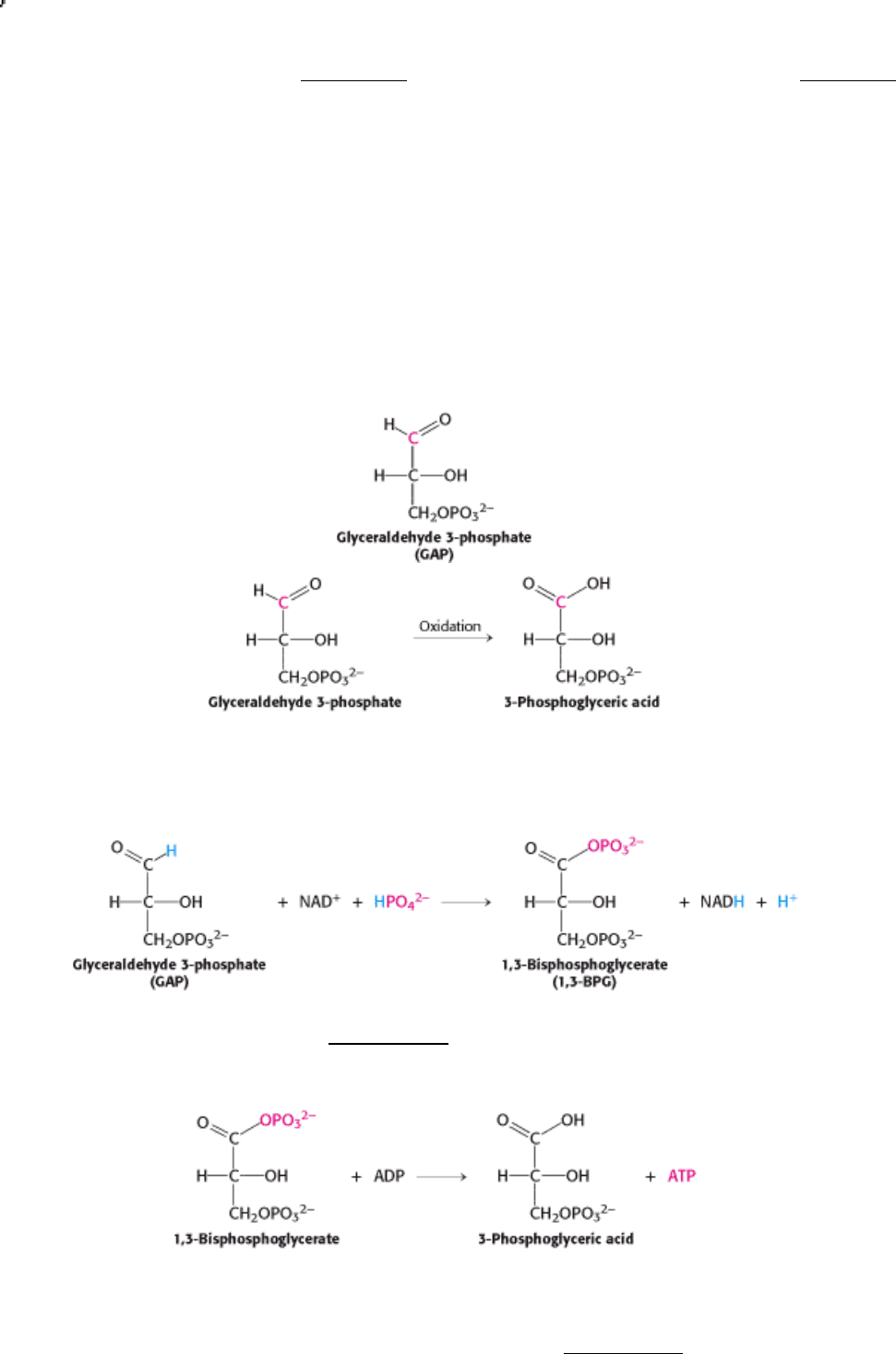
the ∆ G° of oxidation for one-carbon compounds.
Although fuel molecules are more complex (Figure 14.10) than the singlecarbon compounds depicted in Figure 14.9,
when a fuel is oxidized, the oxidation takes place one carbon at a time. The carbon oxidation energy is used in some
cases to create a compound with high phosphoryl transfer potential and in other cases to create an ion gradient. In either
case, the end point is the formation of ATP.
14.2.1. High Phosphoryl Transfer Potential Compounds Can Couple Carbon Oxidation
to ATP Synthesis
How is the energy released in the oxidation of a carbon compound converted into ATP? As an example, consider
glyceraldehyde 3-phosphate (shown in the margin), which is a metabolite of glucose formed in the oxidation of that
sugar. The C-1 carbon (shown in red) is a component of an aldehyde and is not in its most oxidized state. Oxidation of
the aldehyde to an acid will release energy.
However, the oxidation does not take place directly. Instead, the carbon oxidation generates an acyl phosphate, 1,3-
bisphosphoglycerate. The electrons released are captured by NAD
+
, which we will consider shortly.
For reasons similar to those discussed for ATP (Section 14.1.4), 1,3-bisphosphoglycerate has a high phosphoryl transfer
potential. Thus, the cleavage of 1,3-BPG can be coupled to the synthesis of ATP.
The energy of oxidation is initially trapped as a high-energy phosphate compound and then used to form ATP. The
oxidation energy of a carbon atom is transformed into phosphoryl transfer potential, first as 1,3-bisphosphoglycerate and
ultimately as ATP. We will consider these reactions in mechanistic detail in Section 16.1.5.

14.2.2. Ion Gradients Across Membranes Provide an Important Form of Cellular
Energy That Can Be Coupled to ATP Synthesis
The electrochemical potential of ion gradients across membranes, produced by the oxidation of fuel molecules or by
photosynthesis, ultimately powers the synthesis of most of the ATP in cells. In general, ion gradients are versa-tile means
of coupling thermodynamically unfavorable reactions to favorable ones. Indeed, in animals, proton gradients generated
by the oxidation of carbon fuels account for more than 90% of ATP generation (Figure 14.11). This process is called
oxidative phosphorylation (Chapter 18). ATP hydrolysis can then be used to form ion gradients of different types and
functions. The electrochemical potential of a Na
+
gradient, for example, can be tapped to pump Ca
2+
out of cells
(Section 13.4) or to transport nutrients such as sugars and amino acids into cells.
14.2.3. Stages in the Extraction of Energy from Foodstuffs
Let us take an overall view of the processes of energy conversion in higher organisms before considering them in detail
in subsequent chapters. Hans Krebs described three stages in the generation of energy from the oxidation of foodstuffs
(Figure 14.12).
In the first stage, large molecules in food are broken down into smaller units. Proteins are hydrolyzed to their 20 kinds
of constituent amino acids, polysaccharides are hydrolyzed to simple sugars such as glucose, and fats are hydrolyzed to
glycerol and fatty acids. This stage is strictly a preparation stage; no useful energy is captured in this phase.
In the second stage, these numerous small molecules are degraded to a few simple units that play a central role in
metabolism. In fact, most of them
sugars, fatty acids, glycerol, and several amino acids are converted into the acetyl
unit of acetyl CoA (Section 14.3.1). Some ATP is generated in this stage, but the amount is small compared with that
obtained in the third stage.
In the third stage, ATP is produced from the complete oxidation of the acetyl unit of acetyl CoA. The third stage consists
of the citric acid cycle and oxidative phosphorylation, which are the final common pathways in the oxidation of fuel
molecules. Acetyl CoA brings acetyl units into the citric acid cycle [also called the tricarboxylic acid (TCA) cycle or
Krebs cycle], where they are completely oxidized to CO
2
. Four pairs of electrons are transferred (three to NAD
+
and one
to FAD) for each acetyl group that is oxidized. Then, a proton gradient is generated as electrons flow from the reduced
forms of these carriers to O
2
, and this gradient is used to synthesize ATP.
II. Transducing and Storing Energy 14. Metabolism: Basic Concepts and Design 14.2. The Oxidation of Carbon Fuels Is an Important Source of Cellular Energy
Figure 14.8. ATP-ADP Cycle. This cycle is the fundamental mode of energy exchange in biological systems.
